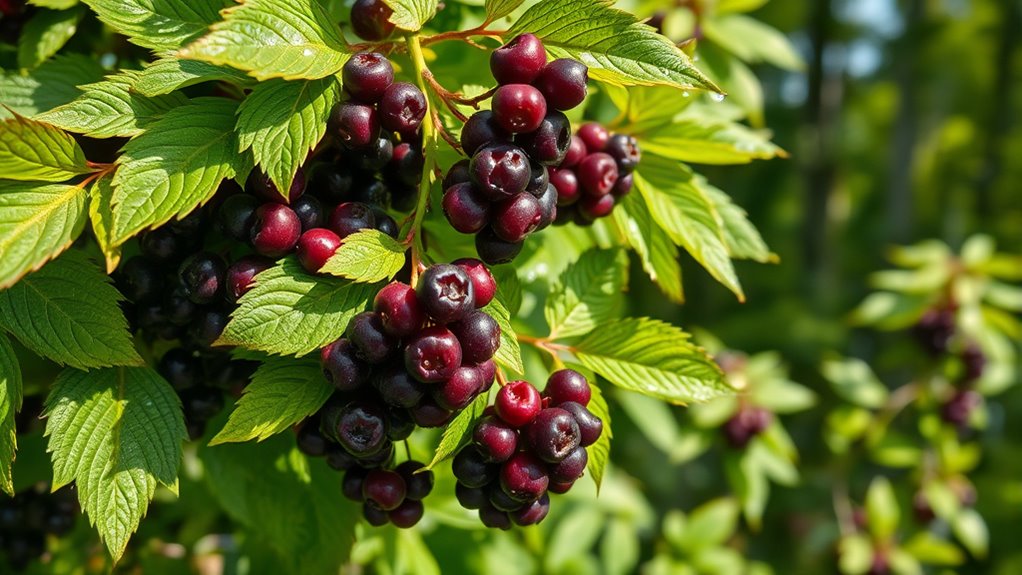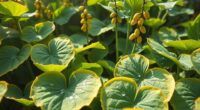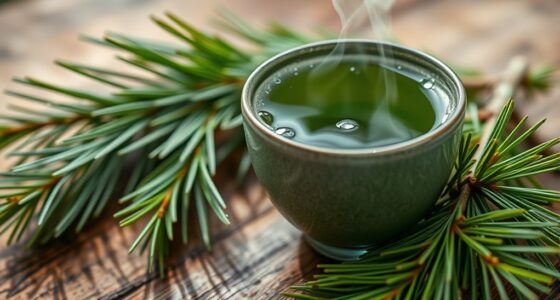Elderberry foraging lets you gather nutrient-rich berries that boost your immunity, fight inflammation, and support overall health. When harvesting, look for dark purple to black clusters on shrubs with compound leaves, and verify the berries are ripe before picking. Use the berries to make delicious syrups, jams, or beverages at home, but always identify the plant carefully to stay safe. To discover simple steps for harvesting, preparing, and preserving elderberries, continue exploring this helpful guide.
Key Takeaways
- Properly identify ripe elderberries in the wild to ensure safety and maximize health benefits.
- Elderberries are rich in antioxidants, vitamins, and phytonutrients that support immune health and reduce inflammation.
- Harvest elderberries when dark purple or black, typically from late July to September, for optimal flavor and medicinal potency.
- Elderberry syrup can be homemade by simmering ripe berries with sweeteners and spices, providing a natural remedy for colds and flu.
- Store elderberry products properly by freezing or drying to preserve their nutritional value and extend shelf life.
How to Identify Elderberries in the Wild
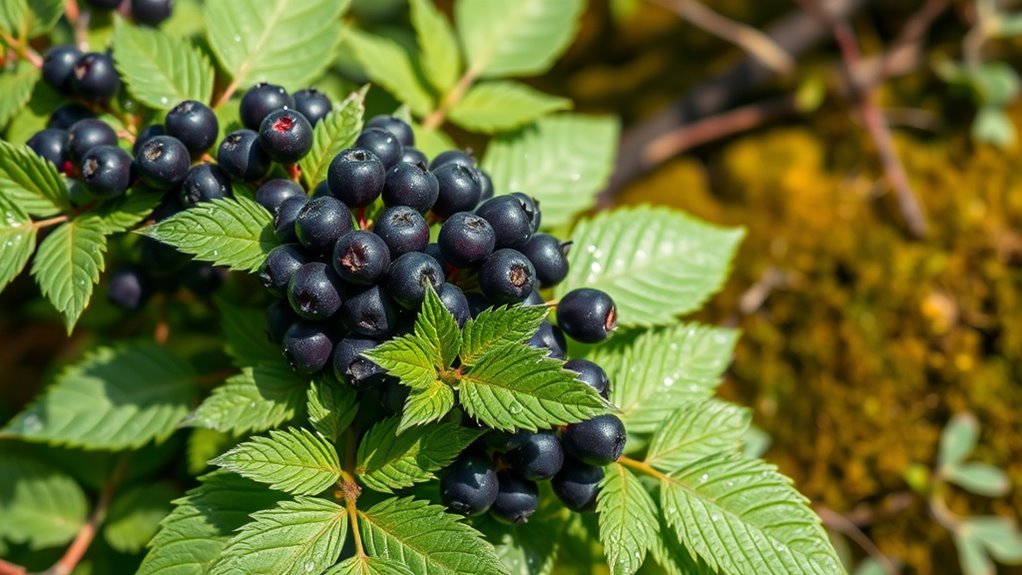
To identify elderberries in the wild, start by examining the plant’s overall structure. Elderberry plants are usually shrubs or small trees with multiple stems emerging from the base, rarely exceeding 3 inches in diameter. Look for compound leaves made up of 5-11 leaflets, typically 7-9, which are lance-shaped or oblong with serrated edges. The bark is light gray to brown, featuring shallow furrows and darker lenticels. Feel the leaves; black elderberry leaves are somewhat fuzzy, whereas blue elderberry leaves are smooth and silky. Check the stems; the pith in second-year growth can help confirm the species. Recognizing these physical traits helps distinguish elderberries from other plants in their habitat, especially considering the plant identification techniques that can aid in safe foraging. Additionally, noting the flowering patterns and fruit clusters can further assist in accurate identification. Observing the plant’s seasonality is also helpful, as elderberries typically flower and fruit during specific times of the year, which can be cross-referenced with local growing seasons for more precise identification. For added confidence, understanding the habitat preferences of elderberries can help differentiate them from look-alikes and ensure safe foraging.
Optimal Timing for Harvesting Elderberries
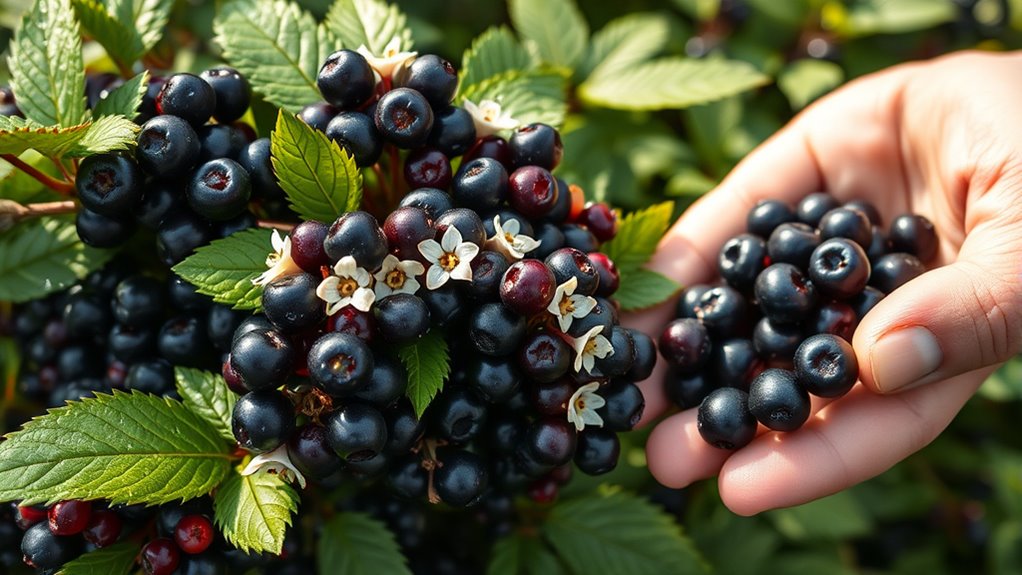
Understanding the right time to harvest elderberries is essential for obtaining the best flavor and medicinal qualities. Ripening varies by region, with southern areas ready as early as May, while higher elevations like the Sierra Nevada peak in September. The main harvest season runs from late July through September, but regular checks are necessary to catch berries at peak ripeness. Look for deep purple, almost black berries, which indicate full ripeness. Clusters ripen gradually over 5 to 15 days, so monitor regularly. Ripe berries have darker stems and are easier to detach from the cluster. Harvesting too early results in unripe, hard-to-remove berries, while waiting too long risks overripeness. Using scissors to cut clusters guarantees easy collection at the right moment. Incorporating timing awareness into your harvesting routine ensures optimal flavor and medicinal potency. Additionally, understanding ripening indicators can help determine the best harvesting window for maximum health benefits. Being familiar with seasonal timing can further optimize your harvest and ensure peak nutritional value. Proper harvesting techniques also help preserve the nutritional value of the elderberries, ensuring you get the most health benefits from your harvest. Recognizing environmental cues can also be useful in assessing the best time for harvest, as weather and climate conditions influence ripening.
Safety Tips for Elderberry Foraging

Ensuring safety while foraging elderberries starts with proper identification and handling. First, recognize that only ripe, dark purple or black berries are safe to eat—avoid unripe berries and red elderberries, which can be toxic. Learn to distinguish elderberries from look-alikes and toxic plants. Using Glycolic Acid benefits as a model, always verify the exact plant species to prevent accidental ingestion of harmful varieties. Additionally, familiarize yourself with reliable plant identification techniques to minimize risks. When harvesting, use sharp tools like pruners to cut clusters gently, and shake them to remove bugs and debris. Always wear gloves to protect your skin from sap and potential irritation. Proper knowledge of the plant’s growth habits can further help in avoiding misidentification and ensuring a safe foraging experience. Being aware of the local environment is also crucial, as contamination from pollutants or pesticides can pose health risks.
Be mindful of your environment—choose safe, uncontaminated sites and respect local regulations. Limit your harvest to what’s needed, preserving plant health and wildlife access. Properly handle and process the berries after harvesting to prevent contamination and ensure safety during preparation. It’s also helpful to educate yourself on foraging safety practices to further reduce risks associated with wild harvesting.
Nutritional and Medicinal Benefits of Elderberries
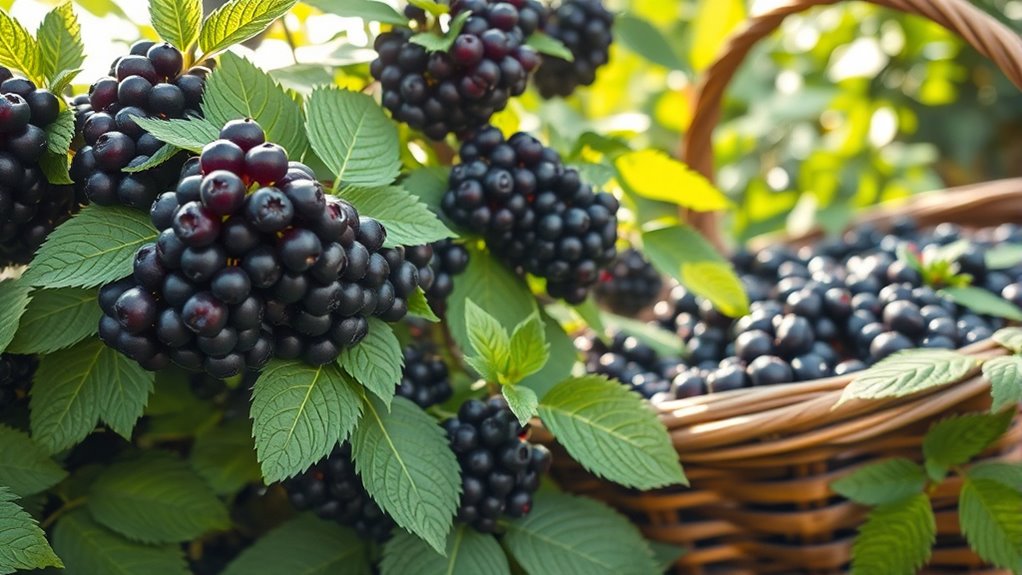
Elderberries are a nutritional powerhouse, offering a wide range of health benefits thanks to their rich content of antioxidants, vitamins, and phytonutrients. These berries help protect your cells from damage and support overall health with their high vitamin content.
They’re also packed with dietary fiber and potassium, which promote healthy digestion and heart function. The phytonutrients and plant sterols found in elderberries contribute to reducing inflammation, managing cholesterol, and supporting immune health. Symptoms of breast cancer awareness can help guide individuals to seek early diagnosis and treatment, potentially saving lives.
Research shows that elderberries may help relieve cold and flu symptoms, improve metabolic health, and even support blood pressure regulation. Their antioxidant-rich profile not only boosts your immune system but may also lower your risk of chronic diseases like heart disease and cancer, making elderberries a valuable addition to your diet. Additionally, understanding relationships and emotional health can enhance your overall well-being and resilience.
Furthermore, incorporating elderberries into your diet may influence your aura by reflecting a vibrant and balanced emotional and spiritual state, promoting overall harmony. A deeper understanding of data privacy challenges can help individuals make informed choices about their health information and personal data. Recognizing the importance of immune system support underscores how elderberries contribute to disease prevention and health maintenance.
Step-by-Step Guide to Making Elderberry Syrup
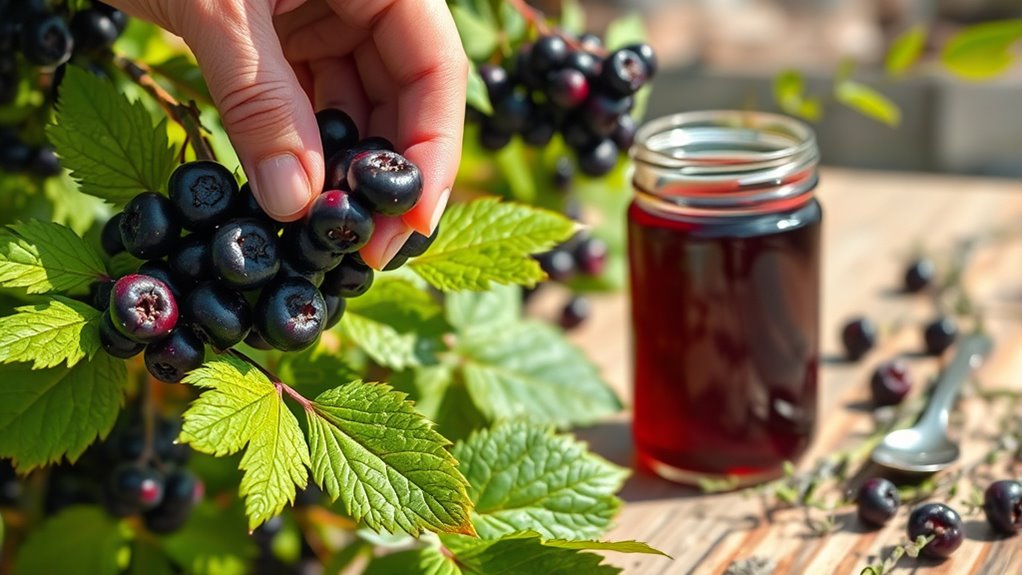
To make elderberry syrup at home, start by gathering your ingredients: dried elderberries, water, spices like cinnamon, cloves, and ginger, and a natural sweetener such as honey.
Use dried elderberries because they last longer than fresh ones. Combine 1 cup of dried elderberries with 3 cups of water in a large pot. Add your chosen spices for flavor and health benefits.
Opt for dried elderberries, combine with water, and add spices for a flavorful, long-lasting syrup.
Bring the mixture to a boil, then reduce the heat and simmer for 30-45 minutes, allowing the liquid to reduce by half.
Let it cool slightly, then strain through a fine mesh or cheesecloth, pressing out all the liquid.
Mix in about 1 cup of honey, stirring until fully dissolved.
Store the syrup in an airtight glass container in the refrigerator for up to two months.
Creative Ways to Use Elderberries in Cooking and Beverages
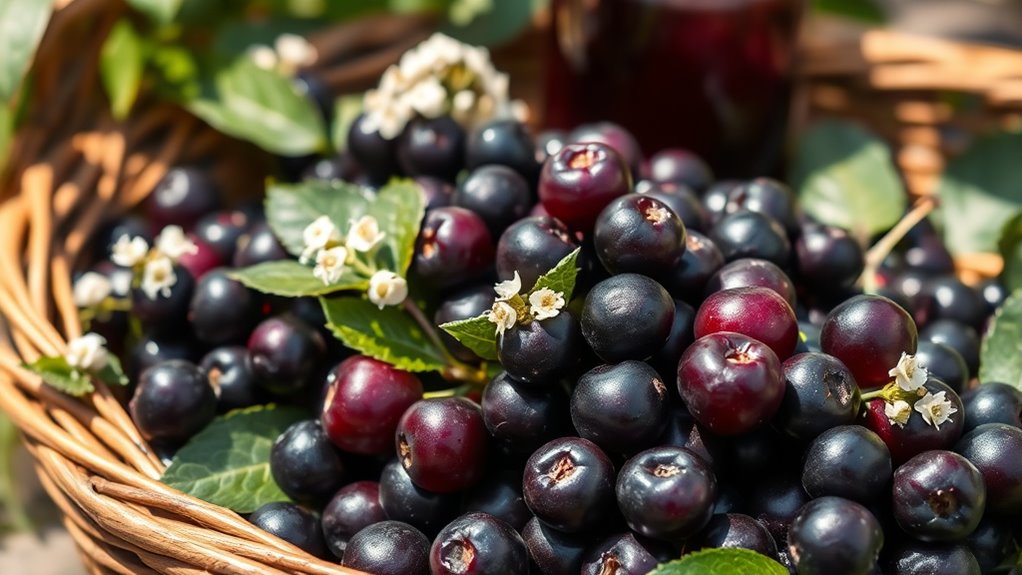
Once you’ve mastered making elderberry syrup, you can explore a variety of creative ways to incorporate elderberries into your cooking and beverages. Use ripe elderberries to make elderberry jelly, a sweet and tangy spread perfect for toast or filling cakes. Combine elderberries with spices like cinnamon, allspice, and cloves to create flavorful spiced elderberries as a condiment. For drinks, craft elderberry wine, a fermented beverage with a unique flavor, or blend elderberries into smoothies for a nutritious boost. You can also make elderberry tea, elderflower spritzers, or elderberry kombucha for invigorating beverages. Additionally, understanding the application timing of elderberries in recipes can enhance their flavor and health benefits. Proper harvesting techniques are essential to ensure the berries’ optimal ripeness and safety. These versatile uses highlight elderberries’ culinary potential, allowing you to enjoy their health benefits while adding vibrant flavors to your meals and drinks.
Storage and Preservation of Elderberry Products
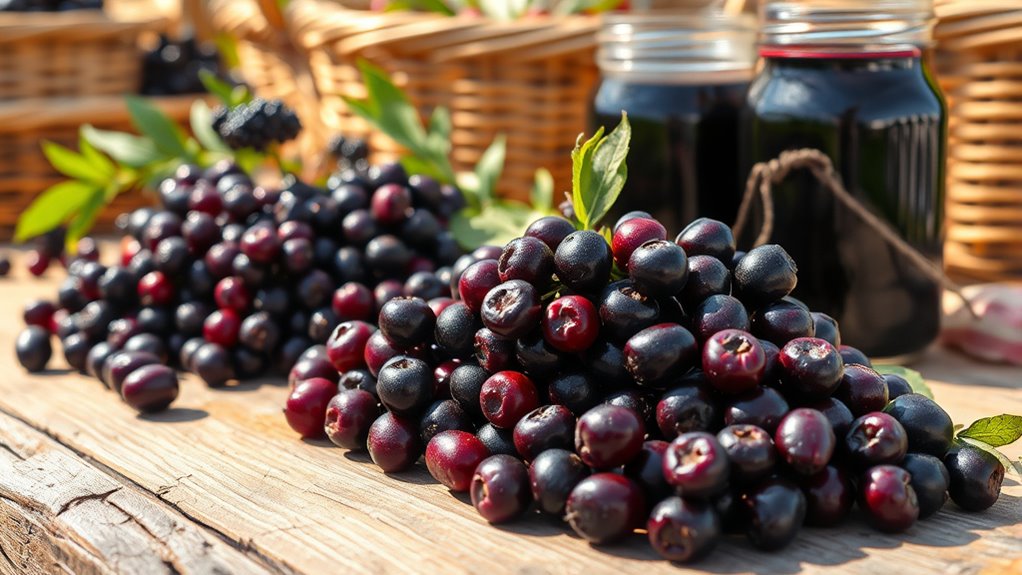
Proper storage and preservation methods are essential to maintain the quality, flavor, and safety of your elderberry products. Keep frozen elderberries at temperatures below 0°F (-18°C) using durable, leak-proof packaging like freezer bags or glass containers. Label everything clearly for easy identification.
Fresh elderberries should only be refrigerated for up to two days; for longer storage, freeze them using quick-freezing techniques on parchment-lined sheets before transferring to sealed containers. Proper freezing techniques help prevent freezer burn and preserve nutritional value. Drying elderberries extends shelf life up to a year, and vacuum sealing can further conserve flavor. Using airtight containers is also recommended to prevent moisture and air exposure that could degrade the elderberries over time. Additionally, storing elderberry products in dark, cool environments can help maintain their bioactive compounds and overall potency.
Elderberry syrup lasts about three months in the fridge and can be frozen in ice cube trays for portion control. Always follow safety guidelines, sterilize equipment, and check stored items regularly for spoilage to ensure your elderberry products stay fresh and safe. Proper storage techniques help prevent spoilage and preserve nutritional value, especially when considering storage and preservation methods that maintain the bioactive compounds in elderberries.
Common Mistakes to Avoid When Foraging Elderberries
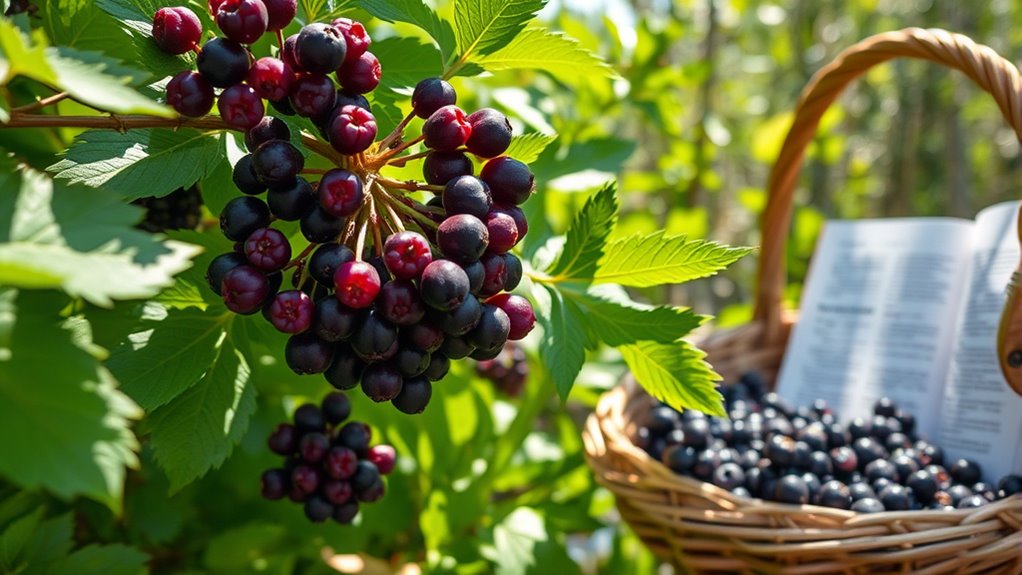
Misidentifying elderberries is a common mistake that can have serious consequences. You might confuse elderberries with plants like Chinese Privet or Arrowwood, which are toxic. Pay close attention to the plant’s characteristics, such as the leaf shape and growth pattern, to avoid misidentification.
Always check the berry color—ripe elderberries should be dark purple. Don’t ignore environmental clues; elderberries thrive in moist, sunny areas near water.
Confirm the plant’s species before harvesting to ensure safety. Rushing the process can lead to dangerous mistakes. Take your time to verify each plant thoroughly.
Proper identification prevents poisoning and guarantees a safe, enjoyable foraging experience. Remember, misidentification can have serious health repercussions—so be cautious and sure before you harvest.
Frequently Asked Questions
Can Elderberries Be Eaten Raw Without Cooking?
You shouldn’t eat elderberries raw because they contain toxic compounds like cyanogenic glycosides, which can turn into cyanide in your body. Consuming raw elderberries might cause nausea, vomiting, or diarrhea.
Seeds can lead to cyanide buildup. To stay safe, always cook elderberries thoroughly before eating or making products like syrup, ensuring you remove seeds, stems, and leaves to avoid poisoning or adverse reactions.
Are There Any Elderberry Varieties That Are Toxic?
Think of elderberry varieties as different roads in a forest; some lead safely, others risk hidden dangers. Yes, some elderberry varieties, like the European Elder, are edible when prepared properly, but others can be toxic if misidentified or eaten raw.
You need to be cautious, ensuring proper identification and cooking. The American Elder is generally safe when fully ripe and cooked, but avoid unripe berries or parts like stems and leaves.
How Do I Differentiate Between Edible and Poisonous Parts of the Elder Plant?
To tell edible from poisonous parts of the elder plant, look for ripe berries that are deep purple or black and easily detach from clusters. Avoid green, unripe berries, leaves, stems, and seeds, as these contain toxins.
Ripe berries are safe only after cooking, which destroys harmful compounds. Always identify elderberries carefully, and steer clear of lookalikes like water hemlock to prevent poisoning.
What Are the Signs of Elderberry Plant Poisoning?
You want to know the signs of elderberry poisoning. If someone ingests toxic parts, they may experience nausea, vomiting, or diarrhea.
Severe cases can lead to confusion, weakness, or even coma. Respiratory depression is also a warning sign.
Watch for these symptoms, and if they appear, seek medical help immediately. Prompt treatment and monitoring are essential to prevent serious health complications.
Is It Safe to Pick Elderberries From Urban or Roadside Environments?
Picking elderberries from urban or roadside areas isn’t completely safe due to contamination risks from pollutants, heavy metals, and pesticides. You need to identify the plant correctly, ensuring you’re not mistaking it for toxic species.
Also, avoid harvesting in protected areas or places with high human activity. Always wash and cook the berries thoroughly to eliminate toxins.
Conclusion
While foraging elderberries connects you to nature’s bounty, rushing the process can lead to risks. Embrace the patience needed to harvest and prepare them safely, savoring their vibrant health benefits. In the quiet moments of making syrup or experimenting with recipes, you’ll find a rewarding balance between nature’s generosity and your mindful care. Cherish the journey as much as the harvest, and let each step deepen your appreciation for this wild, healing treasure.

